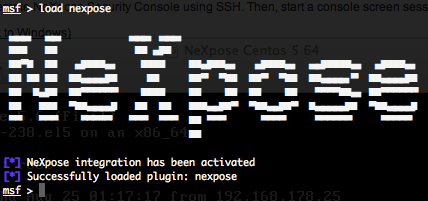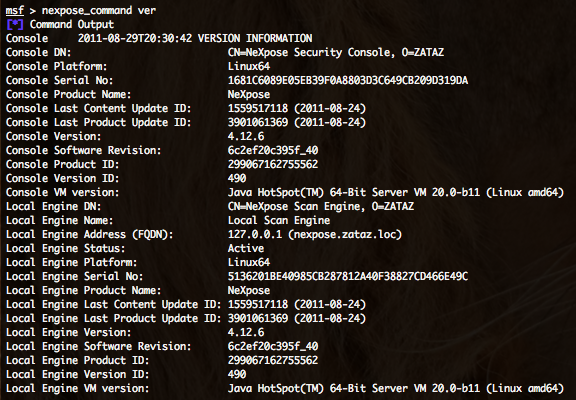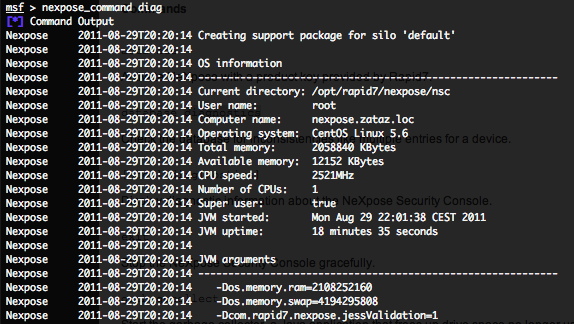 Metasploit include a bridge plugin between the penetration testing framework Metasploit and the vulnerability management scanner NeXpose from Rapid7. This blog post will describe on how to use the basic commands of this bridge plugin.
Metasploit include a bridge plugin between the penetration testing framework Metasploit and the vulnerability management scanner NeXpose from Rapid7. This blog post will describe on how to use the basic commands of this bridge plugin.
As pre-requirements to use the NeXpose bridge plugin, you need first to use Metasploit with a database backend. To connect Metasploit to a database backend just follow the “db_connect” command :

The “db_connect” command will create automatically the database and related tables.

To verify the database connection you can use the “db_status” command.

You can now load the NeXpose bridge plugin with the “load nexpose” command.

Generic commands
- Connecting to NeXpose – nexpose_connect :
To connect to NeXpose, just type :
nexpose_connect login:password@nexpose_ip:port <ssl ok>
“login” and “password” variables are you’re NeXpose user login and password. “nexpose_ip” variable is the IP address or the hostname of NeXpose instance. “port” variable is the port where NeXpose is listening, by default 3780/tcp. “ok” variable is for letting you know that nessus use a self signed certificate and that risks are present.


- Logout from NeXpose – nexpose_disconnect :
To disconnect from NeXpose, just run the following command :

- Checking NeXpose system information – nexpose_sysinfo :
To check the NeXpose system information (db version, java informations, uptime, installation directory, free memory, last update id, etc.), run the following command :

NeXpose Useful Commands
- Getting help for NeXpose commands – nexpose_command help :
To have a complete list of all NeXpose commands, just run the following command.

- Getting NeXpose versions informations – nexpose_command ver :
This command will display the current software version, serial number, most recent update.

- Updating NeXpose engines – nexpose_command update engines :
The following command will send pending updates to all defined Scan Engines.

- Check and apply NeXpose updates – nexpose_command update now :
The following command will check for and apply updates manually and immediately, instead of waiting for an automatic, scheduled update.

- Getting NeXpose server scheduled jobs – nexpose_command schedule :
The following command will Display the currently scheduled jobs such as scans, auto-update retriever, temporal risk score updater, data warehouse exporter, and log rotation.

- Getting a NeXpose database diagnostics- nexpose_command database diagnostics :
The following command will check the database for inconsistencies, such as multiple entries for an asset.

- Getting a complete NeXpose diagnostics – nexpose_command diag :
The following command will display diagnostic information that may be useful for debugging or monitoring of activity.

- Stopping NeXpose – nexpose_command exit or nexpose_command quit :
These both commands will stop the NeXpose server.

- Restarting NeXpose – nexpose_command restart :
This command will restart the NeXpose server.

- Ping a host from the NeXpose server – nexpose_command ping HOST [PORT] :
This command will ping the specified host using an ICMP ECHO request, TCP ACK packet, and TCP SYN packet. The default TCP port is 80.

- Traceroute from the NeXpose server – nexpose_command traceroute HOST :
This command determine the IP address route between your NeXpose server and the host name or IP address that you specify.

In the next blogpost we will describe all commands related to sites, site devices, scans.











